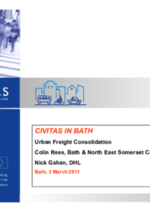Urban Freight Consolidation
Summary
A Freight Consolidation Depot serving the neighbouring cities of Bath and Bristol has been trialled by Bath & North East Somerset Council and Bristol City Council.
Implementing sustainable mobility
The measure sought to reduce the number of large delivery vehicles entering central Bath by providing a facility, on the edge of the city close to the strategic road network, where goods can be consolidated for onwards dispatch in a smaller, electric vehicle.
Bath & North East Somerset Council worked in partnership with neighbouring Bristol City Council to establish the first urban freight consolidation centre in the UK which serves two cities. Bristol first set up a freight consolidation operation as part of the CIVITAS I VIVALDI project.
Goods for the participating retailers are being delivered to a warehouse outside of the city, next to the UK motorway network. These goods are consolidated for onwards dispatch into central Bath in pre-arranged time slots using a low emission electric delivery vehicle.
Progress
A comprehensive survey of retailers in Central Bath was undertaken to establish a baseline position for deliveries into the area and to ascertain expected demand for a freight consolidation operation. A joint exercise with Bristol City Council to procure a contractor to operate the freight consolidation centre was then carried out.
The Urban Freight Consolidation demonstration project commenced on 4th January 2011 and ran until 14th June 2012. The consolidation centre continues to serve Bath and Bristol beyond the completion of the CIVITAS RENAISSANCE project.
Outcomes
• Emissions Reductions - January 2011 to end of April 2012: CO2 10,179.74 Kg CO 60.83 Kg NOx 330.86 Kg PM10s 9.89 Kg • The electric vehicle achieved a 55.7% reduction in energy consumption • Average concentration of Nitrous Oxide levels in Bath in 2011 fell to 45μg/m3 below the target of 47μg/m3 • 20 retail outlets representing 15 businesses were participating in the scheme after 17 months (Target 30 retail outlets) • The number of deliveries to participating outlets have been reduced by 76% (Target 70%) • The cost of the subsidising the scheme reduced from €221,910 in year 1 to €141,083 in year 2 when a small charge was introduced.









